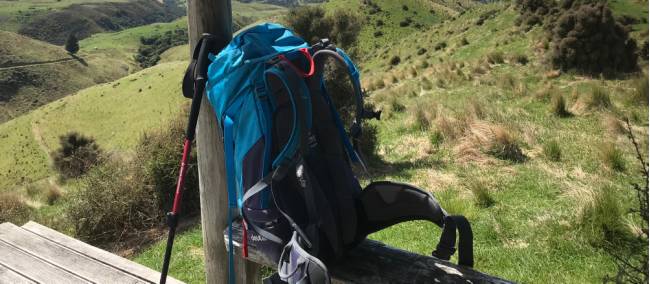
Time to put the pack down and simply admire the view from Skull Peak | Janet Oldham
Blog home / 3 gear mistakes to avoid when going on a trek
If you’re a new player wishing to hit the trails for the first time, it’s best to keep these helpful tips and tricks in mind so you can make your outdoor experience as enjoyable and stress-free as possible.
#1: Bringing too much luggage
Just because it fits, doesn't mean you should take it. A big thing we notice among first-time trekkers is the overwhelming desire to take everything they own when on the trails.
Ultimately, it is important to remember that whatever you pack you will have to carry, especially on trips where luggage transfers are not included. Heavy packs for those that lack experience carrying large loads for long distances, elevates risk of discomfort and potential injury when taking on a hike covering a greater distance. Consider taking your load on a day hike as preparation before attempting a long-distance or multi-day hike.
The best way to distribute weight:
Everyone has his or her own tricks of the trade in terms of packing a backpack. It will vary depending on the pack as well as the gear you put in it.
• Ensure the weight is evenly distributed between the left and right side of your pack. Try to pack heavy items horizontally to avoid having one side of your pack abnormally heavier than the other.
• Don’t overpack your pack. Just like an overfilled suitcase, an overfilled pack results in having to pull out too many things to find what you are looking for. Leaving room allows space for you to rummage to find the items that you need without pulling everything out.
• Make sure you always pack things you might need often (water bottle, camera, lights, insect repellent, water filtration) in places that are easily accessible, such as the top of main pockets or exterior pockets of the pack.
• If you don’t have side pockets, attaching water bottles to straps with a carabiner does the trick and makes your water bottle accessible. Also works if you are carrying a travel pillow with you attaching to the outside, leaving room on the inside.
#2: Wearing incorrect footwear
"The golden rule to a great walk is great shoes!"
More often than not, there are trekkers that embark on trails for the first time, with completely insufficient footwear. Gym shoes/trainers although super comfortable for everyday use, will not cut the mustard on a longer, multi day trek.
Shoes are an all-important investment when you embark on a walk. They will dictate how sore your muscles are feeling at the end of the day. Whether your feet are blister free. How your lower back feels.
Making sure your shoes are trek ready:
• Consider the terrain and the grading of the trip. The harder the grading, the more likely the terrain is uneven and remote and footwear with good ankle support will be needed to keep you from rolling your ankle or causing yourself injury.
• Wear your shoes. Never embark on a trek with a brand new pair of shoes. It always takes some time for your foot to ‘mould’ to the shoe, so make sure you give yourself plenty of time to train with your shoes before taking them out on the trail.
• Ensure your shoes have good grip and good tread as this will assist you when the conditions get a little wetter or a little more uneven under foot.
• Make sure you take the correct socks into account when trying on/buying shoes. Socks are just as important as shoes and ensuring you have a good pair of socks to suit the conditions is vitally important. Regular socks are not the same as trekking socks.
#3: Skimping out on trekking poles when you experience joint or muscle pain
Trekking poles can be classified as an absolute necessity for some, whereas for others they can take up precious pack space. Trekking poles help distribute weight, aid with balance, help some people keep pace as well as alleviate joint and muscle pain.
For the less agile or for people prone to joint or muscle pain, we would recommend trekking poles. They can help ease the stress on your hips, leg muscles, ankles and knee joints, and even help correct your posture and thus can reduce back pain and neck strains.
For first time trekkers making hefty investments on new gear, trekking poles could be something you come back for in the future if you don’t classify as someone who needs them for their first trek.
Quick tips for using trekking poles:
• Set your trekking pole at the correct height which may depend on the terrain you are walking along. Your shoulders should be relaxed and your elbows by your side. A general rule is having your pole at a height that your arm forms a 90-degree angle.
• Properly adjusting your wrist straps is important to maintain control in case you stumble. Ensure that the strap crosses the palm and wraps beneath the thumb, then tighten or loosen the strap as needed. It shouldn't be too tight that it restricts movement or circulation, just tight enough to support the weight of your hand in the pole.
• If unsure, check in with an expert. Staff at a good gear store should be able to assist you and recommend suitable poles for your trek.
Happy trekking!